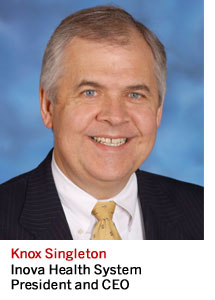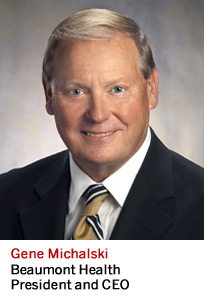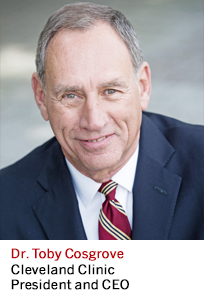 This interview with Dr. Richard Gilfillan, President and CEO of Trinity Health, was conducted by Eric Larsen, managing partner, and condensed by Amanda Wolfe, senior director.
This interview with Dr. Richard Gilfillan, President and CEO of Trinity Health, was conducted by Eric Larsen, managing partner, and condensed by Amanda Wolfe, senior director.
Question: You've touched almost all parts of the health care industry across your career. You've moved seamlessly from the provider to the insurer to the federal space. Let's start at the beginning, though—how did you get into medicine?
Richard Gilfillan: Growing up in an Irish-American family in New England in the early 1960s, I became excited about the value of public service during Kennedy's run for president. That idea of a career dedicated to public service stuck with me and has guided many of my career decisions.
At first, I thought I wanted to go to law school and then ultimately into politics, so I went to Georgetown University School of Foreign Service. In the midst of all that was going on in the 60s, I started to question whether entering politics directly would be the best way to make meaningful change.
I took a biology course and found that I really enjoyed science. That led me to think about going into medicine. I believed that would give me the opportunity to provide meaningful service as a doctor and also expose me to the social side of health care where there were significant public policy issues, even then.
Q: What made you decide to explore the business side of medicine?
Gilfillan: Throughout my career, I have tried to learn about and practice in as many sides of our system as possible. I thought I could be most effective if I had a deep understanding of the underlying dynamics of our system. That’s why from the beginning, I exposed myself to the business and operational side of health care. Early on in medical school I worked in a very early pre-paid medical practice that became an HMO. After residency, I went back to D.C. to work in that group practice, which was becoming part of the Kaiser Permanente Medical Group.
After that, I started a three-person family doctor group in a town of 7,000 people. I was also on the board of our local independent practice association to learn more about the managed care world, and I decided that was a great place to gain exposure to the broader financing side of care delivery. We were just beginning to look at population data and understand how different delivery models could develop better outcomes for our patients. I was excited about the potential for developing care and payment systems that could improve outcomes and control costs.
So I took a position as a half-time medical director, half-time primary care doctor at a staff model HMO in Trenton, New Jersey. It provided a great early education in the broader aspects of population health and the business side of health care, including insurance, financing, and quality improvement.
Q: So at that point, you'd already had some hands-on business experience, but then you went on to get your MBA from Wharton. What made you decide to pursue that route?
Gilfillan: I realized that I really needed to better understand how the business folks I was working with viewed the world. We were doing lots of interesting things trying to improve care and manage costs, but I didn’t have a deep understanding of the way they came at the world. I thought business school would give me the technical knowledge and the exposure to business people that would rapidly expand my understanding of the dynamics of our system.
Innovative care models and the 'Triple Aim'
Q: One really interesting opportunity for hospitals under the Affordable Care Act is experimenting with new payment models. You've had an inside view of how those work, both because you helped develop such models and because you've had direct experience working under them. How did you get started down the path of delivery innovation?
Gilfillan: At Independence Blue Cross, I worked on various capitation, episode-based payment and PCP incentive programs. Then I became the head of national network contracting for Coventry Health Care. Alan Wise, Coventry's CEO, and I talked about the need to find a better way to take care of folks with Medicare. So I went around the country looking at different models of care for Medicare patients. I saw some very effective models and began creating medical home-type models in several of our markets.
Then I met Glenn Steele at Geisinger. He was very interested in exploring what we could accomplish by developing a deeper partnership between a payer and providers. So I went there and eventually our team created new clinical and reimbursement modes for primary and specialty care that were based on that deep payer-provider partnership. Those were our Proven Health Navigator and ProvenCare models. In all, we used the Triple Aim as our measure of success. We thought that if we could demonstrate real improvement in outcomes for the populations we served, this partnership approach might be a model for what could be done nationally.
Q: You took some your experience with care models to CMS. What were you hoping to do there?
“ Back in the 90s, our value equation was that: Value = Quality x Patient Choice, divided by Cost. ”
Gilfillan: My original goal was to continue this work of integrating delivery and financing to produce better outcomes for populations. Back in the 90s, our value equation was that: Value = Quality x Patient Choice, divided by Cost. So you make choice better, you make quality better, you make cost lower—all of these drive value up. Now we say better health, better care, reduced costs. It is the same mission many of us have been on for a long time.
When I was first looking for a job at CMS, I was open to any job that would give me a chance to work on the delivery system changes in the ACA. I was very fortunate that Jonathan Blum and Liz Richter gave me the opportunity to lead the team that was writing the ACO regulations. I started there, but then Don Berwick asked me to start up the Center for Medicare and Medicaid Innovation, a new Center for CMS that was created in the ACA. Our charge was to create and test new clinical and payment models. So it was a great fit. It was an incredible privilege and honor to work with all the people at CMS and HHS who worked so hard on implementing the ACA delivery system initiatives. I am very hopeful that we will see dramatic change in our ability to really produce the Triple Aim as a result. [editor's note—Gilfillan was the first head of the Center for Medicare and Medicaid Innovation.]
Q: And now, you're back in the private sector, where you're dealing first-hand with those care models as CEO of Trinity Health. You've said you want to have a Medicare Shared Savings Program (MSSP) Accountable Care Organization in every one of Trinity Health's markets. Why is that important?
Gilfillan: First because it directly aligns with our mission to be a compassionate transforming healing presence within our communities — to deliver better outcomes for our patients.
Second, the MSSP provides us with a business model that supports that mission. I believe a central component of our business in the future will be being accountable for the total outcomes for a population. We will succeed if we excel at delivering better health, better care and reduced costs for that population. We thought that the Shared Savings Program would be a straightforward way of beginning to learn how to do that. It also provides a great way for us to get started — we will become accountable for a population, learn how to manage claims data, how to profile a population, how to do predictive modeling, case management, etc. It provides a business rationale for doing all the things we have all wanted to do for a long time.
Third, it was a stress test for our regional health ministries. It required us to build deeper relationships with our physicians and to find out what our potential was to create clinically integrated networks in each ministry. Finally, while the program may not be perfect today we expect that, over time, CMS will modify it to ensure that it is sustainable. We will use this population management foundation to care for more populations covered by other payers. It will be a key driver of our evolution into a “People-Centered Health System.”
Q: What surprised you most about moving back into the private sector from the federal government?
At CMS, I was optimistic that there was energy around transforming our delivery system. But when I actually got into the private sector, I realized there's more than I anticipated. This was very evident at Trinity Health where the Board is committed to delivery system transformation. But even beyond our organization, I have been surprised by the energy, momentum and acceptance of the belief that we need to and can transform the way we deliver care.
I also learned again that this is hard work in a difficult business. We're saying to very committed, hard-working people: “deliver great care, take care of people who are really sick, give them a better experience, improve your outcomes significantly, do it for less, be innovative, figure out how to redesign the way you deliver care, create a new clinical model, coordinate and integrate care, and oh — by the way — you will have to change your business model because we intend to pay you for value not volume.” These are all the right things to do, but it is a lot to ask of people who are caring for people at their most vulnerable point every day. The remarkable reality is that health care teams across the country are actually accepting the challenge and doing the work.
Focusing on growth at Trinity Health
Q: What does the press release from Jan. 1, 2018, for Trinity Health say?
Gilfillan: Trinity Health has built a truly People-Centered Health System. It is demonstrating remarkable improvements in population health outcomes and lowering costs. We are growing significantly because we have created a differentiated patient experience. And we are doing it in diverse communities from Albany, New York to Ft Lauderdale, Florida to Fresno, California.
Q: Speaking of that, how do you personally think about growth?
Gilfillan: Strengthening and expanding Catholic health care is one of our five strategic focus areas in our new strategic plan — People-Centered 2020. But we believe bigger is only better if it means you can add value — as perceived by people, families, customers and markets. We're interested in growth, but we want to make sure that we're systematic and smart about it. We don't want to pursue deals just to do deals — but because we have an operating model that is scalable and continues to add value as we grow.
Q: What advice do you have for future health care leaders?
Gilfillan: Never lose sight of the fact that leading health care organizations is a great privilege and responsibility. Ours is very important work. Leadership is about establishing clear objectives and measures of success for your organization; creating and executing a strategy for achieving those objectives; choosing great people to be on the team; building a culture that is congruent with your objectives; and modeling behavior that is consistent with that culture. I have always believed you need to be very close to your business. You've got to get down deep and understand the central dynamics that drive your business — both operationally and in terms of your marketplace. Finally, understand where you as an individual can really add value — focus on putting your strengths at the service of the team.
Q: How important was it for you to have mentors along the way?
Gilfillan: I have been fortunate to work with many great leaders. The first was Katherine McHugh, who was a leader at the very beginning of managed care. After my parents, she was my first mentor and taught me a great deal about business, group practice management and health care financing. Fred DiBona, who's since passed away, was our CEO at Independence Blue Cross, Alan Wise at Coventry, Glenn Steele at Geisinger and Liz Richter at CMS. And of course, Don Berwick at CMS and Secretary Kathleen Sebelius at HHS were extraordinary people to work with and learn from. All remarkable people who were great leaders in their own way and each with very deep knowledge about key dimensions of their world. Each of them very generously shared their experiences and knowledge in the normal course of work. I was very fortunate to work with them.
Creating an environment for innovation
Q: Innovation is a clear theme across your career. What are your best tips for fostering it?
Gilfillan: To make our system better, you have to make change — you need to understand your present operations, imagine ways it could be better, try new approaches, fail fast, learn and then spread what works. That is the definition of innovation. I've generally done it as an intrapreneur. I've tried to find positions where it was possible to leverage the results of innovation across larger organizations to the benefit of the populations they serve.
To foster innovation in those environments you need to create the understanding that change is the norm. You need to provide a clear vision of goals of change — the definition of success. So people come to understand that innovation is expected, demanded and rewarded. All that can lead to an environment where people are not only comfortable with innovation, they need to do it. And then you need to study, learn from, enjoy and celebrate the effort, the successes, the failures, and the results.
Q: You mentioned that public service was the catalyst for your interest in medicine. How has health care lived up to your expectations?
Gilfillan: I am very fortunate to be part of an organization with 89,000 talented colleagues who are committed to improving the health of our communities and each person we serve every day. We touch about 5 million people each year. Our Board is very supportive of our strategy to build a People-Centered Health System that we think will improve the lives of those people and the health of their communities. We hope that along with others pursuing a similar approach, we can significantly impact the transformation of our national health care system. It is a real privilege to be here and certainly exceeds any expectations I had. It is a wonderful time to be in health care!
Get more lessons from the C-suite
See the Daily Briefing's archive of must-read interviews with other top hospital and health system leaders, including:
How an English major became a hospital CEO at age 29
In a Q&A with the Daily Briefing, Sandra Bruce explains what she's learned in her decades as a hospital CEO, how two systems overcome bumps in the road to become Presence Health, and what it means to "Lean In" in health care. Read our interview with Sandra.
 Why one Baby Boomer CEO thinks Millennials have 'superior' leadership potential
Why one Baby Boomer CEO thinks Millennials have 'superior' leadership potential
Knox Singleton explains what it's like to lead the same system for 30 years, how a hospital can successfully "humanize" its executives, and his strategy behind shifting Inova's brand.
 How to prove a boss wrong when he thinks you're the second choice? Do what this CEO did.
How to prove a boss wrong when he thinks you're the second choice? Do what this CEO did.
Today, Gene Michalski is the first CEO of Beaumont Health, a newly formed $4 billion health system. But almost 40 years ago, when Michalski applied for the position that launched his career…he was originally the second choice. In an interview with the Daily Briefing, Michalski shares his secret to convincing a wary leader to hire him, how it influenced his own management style, and how he sees the industry. Read our interview with Gene.
 Cleveland Clinic CEO's single best tip on building a career: 'Shamelessly steal.'
Cleveland Clinic CEO's single best tip on building a career: 'Shamelessly steal.'
Toby Cosgrove explains how—despite barely getting into med school—he's now the head of the Cleveland Clinic, how he sees the industry, and how one tactic is key to his management success. Read our interview with Toby.
Most staff aren't naturally great leaders, but studies show that leadership and management can be taught. Use our Leadership Competency Diagnostic to help your managers further develop their strengths and focus on opportunities for improvement.
And it's never too early to start grooming a great manager. See our Succession Management Implementation Guide to ensure you deliberately chose your future leaders—don’t let circumstances choose them for you.
Don't miss out on the latest Advisory Board insights
Create your free account to access 2 resources each month, including the latest research and webinars.
Want access without creating an account?
You have 2 free members-only resources remaining this month remaining this month.
1 free members-only resources remaining this month
1 free members-only resources remaining this month
You've reached your limit of free monthly insights
Become a member to access all of Advisory Board's resources, events, and experts
Never miss out on the latest innovative health care content tailored to you.
Benefits include:
You've reached your limit of free monthly insights

